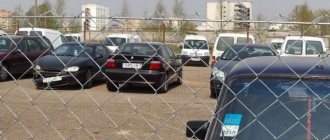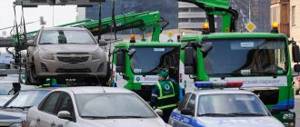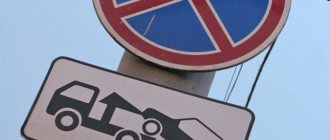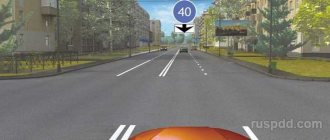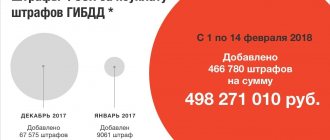When is a car towed, and when is it only a fine?
There are several cases when traffic rules violators are not only subject to fines, but also resort to other measures to suppress the violation. The vehicle of such a car owner will be detained and towed if the parking is carried out:
- four-wheeled (or more) vehicles in the second, third and subsequent rows;
- in the tunnel;
- on the road, provided that the gap from the car to the dividing strip is 3 meters or less;
- in the immediate vicinity of a pedestrian crossing (no more than 5 meters) or on it;
- at a distance of 15 meters or closer from the designated stop for buses, trolleybuses, taxis, if there are no parking spaces in this interval;
- under prohibitory signs, in the presence of a sign informing about the operation of a tow truck;
- where the vehicle blocked the entry/exit of other vehicles;
- on a site intended for disabled people;
- on the pedestrian sidewalk;
- on tram tracks or near them, provided that the car interferes with the movement of the tram;
The vehicle will also be towed if:
- lack of documents for the person driving the car;
- brake system malfunction;
- drug or toxic intoxication of the person driving the vehicle, or his refusal to undergo examination;
- non-compliance with the rules for the transportation of goods (dangerous and/or oversized).
The vehicle is not subject to detention if it is parked:
- under prohibitory signs in the absence of a sign indicating the operation of a tow truck;
- in a bicycle lane (not a path);
- in which the vehicle blocks a traffic light and/or road signs;
- in the immediate vicinity (no more than 5 meters) from or at the intersection;
- in close proximity (no more than 100 meters) to dangerous turns;
- in close proximity (no more than 50 meters) to or on a railway crossing;
- on the edge of the road, if there is a shoulder;
- across the road;
- on the left side of the roadway.
When is car evacuation used?
Towing a car is a compulsory measure designed to ensure proceedings in the case of an administrative violation of traffic rules of the Russian Federation.
In article 27.13. Code of the Russian Federation on Administrative Offenses (hereinafter referred to as the Code), this measure is referred to as the detention of a vehicle.
In contrast to punishment, the purpose of which is to suppress the offense and “repay the offender according to his deeds,” the evacuation of the vehicle to a specialized site is nothing more than a means of achieving this goal.
The law allows for vehicle towing for violations of stopping and parking rules in the following cases:
Article 12.16., part 4 of the Code
failure to comply with the requirements prescribed by road signs or road markings prohibiting stopping or parking of vehicles, with a fine of 1,500 rubles.
Article 12.16., part 5 of the Code
violations provided for in Part 4 of Article 12.16. Code, committed in the federal city of Moscow or St. Petersburg, with a penalty of a fine of 3,000 rubles:
3.27 Stopping is prohibited, 3.28 Parking is prohibited, 3.29 Parking is prohibited on odd days of the month, 3.30 Parking is prohibited on even days of the month, 8.24 A tow truck is in operation
Note: a prerequisite for the possible detention of a car for violations provided for in parts 4-5 of Article 12.16 of the Code is the presence under the prohibition signs of additional information in the form of a sign indicating the use of an evacuation sign in the coverage area.
Article 12.19., part 2 of the Code
violations of parking rules in places intended for disabled people, punishable by a fine of 5,000 rubles:
8.17 Disabled people, 8.18 Except disabled people
Article 12.19., part 3 of the Code
when parking on a pedestrian crossing and closer than 5 meters in front of it, as well as on the sidewalk, with the exception of a forced stop, with a fine of 1000 rubles.
Article 12.19., part 3.1 of the Code
when parking at a stop for fixed-route vehicles or parking places for passenger taxis or closer than 15 meters from these places, with the exception of a stop for picking up or unloading passengers, or a forced stop, with a fine of 1000 rubles.
Article 12.19., part 3.2 of the Code
when parking on tram tracks, or further than the first row from the right edge of the roadway, with the exception of a forced stop, with a fine of 1,500 rubles.
Article 12.19., part 4 of the Code
in case of non-compliance with parking rules on the roadway and creating obstacles for the movement of motor vehicles, when stopping (parking) a vehicle in a tunnel, with a fine of 2,000 rubles.
Article 12.19., part 6 of the Code
in case of violation of those listed in parts 3-4 of Article 12.19. Code, committed in the federal city of Moscow or St. Petersburg, punishable by a fine of 3,000 rubles.
In addition to the material presented above, it should be added that, in accordance with Part 4 of Article 12.19 of the Code, any cars that are parked in violation of Chapter 12 of the Traffic Regulations of the Russian Federation on the basis of creating obstacles to the movement of vehicles on the roadway are subject to evacuation to the impound lot.
The very concept of “creating obstacles” is strictly evaluative in nature and can be reasonably applied by any traffic police officer when making a decision to evacuate a car to an impound lot.
Thus, drivers who park their iron horses in violation of stopping and parking rules should not underestimate the risks.
What documents regulate the procedure for detaining a vehicle?
The rules for the detention and evacuation of vehicles are regulated by the Federal Law “On Road Traffic Safety”, as well as the Code of Administrative Offenses of the Russian Federation. Both of these documents were amended in 2015 and 2021, respectively.
The essence of the changes dated June 8, 2015:
- The detained vehicle is returned to a person who can drive it directly at the scene of the violation if the reason for the detention is eliminated. That is, if the car was parked incorrectly, but the driver managed to return before the car was taken away, the vehicle is returned to his disposal. But if the tow truck has already started moving, the car can only be picked up from the impound lot.
- An official (traffic police inspector) must remain at the place where the car was detained until it is evacuated. The amendment was adopted so that the driver, if he has time, can return his vehicle, because only the person who made the arrest can return the car to the owner.
- If the official does not comply with the owner’s request to return the vehicle to him before the tow truck starts moving (provided that he can drive it), he is subject to a fine of 20,000 rubles.
- Evacuation is provided for parking in a disabled spot.
- If there is no sign under the signs “Stopping and parking prohibited” or “Parking prohibited” indicating the operation of a tow truck, it is impossible to detain the vehicle.
The essence of the changes from September 1, 2021:
- Reimbursement for vehicle towing costs can be paid after the vehicle is collected from the impound lot.
- The owner or the person replacing him is required to provide a copy of the detention protocol, even if the protocol itself was drawn up without his participation.
- Tariffs for evacuation services and the presence of vehicles in impound lots are subject to state regulation.
Requirements for impound lots
In most cases, special parking lots for evacuated cars are private territory, and services are provided by private companies. That is why, in order to protect the vehicle until it is returned to the owner or sold, there are a number of rules for the operation of the impound lot.
Each penalty parking lot must:
- At the impound lot, the organization must have equipment at its disposal that can load and unload cars.
- There must be a cash register in a specially equipped place (booth, house) where fines will be accepted.
- There must be markings and numbering of places for cars.
- The parking space must be guarded, fenced, and without the possibility of unauthorized entry.
- Fire safety equipment is required.
- The area must be monitored by CCTV cameras.
Recordings from CCTV cameras in such parking lots must be stored for at least 1.5 months.
On the territory of the impound lot there must be a fire well and a hydrant for a prompt response to a fire.
Penalty parking staff are prohibited from:
- allow strangers into the parking area;
- place more cars than indicated by the markings;
- store flammable materials or repair vehicles;
- leave fuel tank hatches open on vehicles;
- charge batteries using external sources.
Register now and get a free consultation from Specialists
Procedure for detention and evacuation
The procedure for detaining a vehicle is strictly regulated. In case of detection of traffic violations that entail evacuation, the law enforcement inspector must:
draw up a protocol indicating the date, exact time, article of the Code of Administrative Offenses of the Russian Federation on the basis of which the detention is carried out, the location of the offense, indicate information about the driver, information about the official who carried out the detention;
- provide a copy of the protocol to the driver;
- draw up a report in the presence of at least two witnesses, or by attaching a video of the car being detained if the driver is not there;
- seal the trunk and all doors to prevent unauthorized persons from entering;
- draw up an inventory of valuable property located in the car at the request of the owner;
- remain at the detention site until the tow truck starts moving.
After this, the car can only be picked up from the impound lot. If the inspector’s decision was unlawful, the requirement to pay for evacuation services can be appealed within 10 days.
What's next?
The deposit can then be returned to the driver or used to pay the fine. It is logical to assume that a refund occurs only if the proceedings against the driver are terminated - if the fact of intoxication or the presence of a corresponding violation is not established. But, again, this is not directly stated in the new bail law.
When making a decision in a case of an administrative offense, the judge decides on the return of the deposit for a detained vehicle to the pledgor or on the transfer of the deposit for a detained vehicle to the state in payment of an administrative fine for the relevant offense, as indicated in the resolution on the case of an administrative offense.
How to find out whether evacuation or theft has occurred
Often, vehicles are towed away in the absence of the driver (for example, for illegal parking) and the driver does not know what exactly happened to his property (towing or theft). What to do in such a situation and where can I get information?
You can find out about the evacuation of a vehicle to a specialized impound lot:
- at the regional traffic police department. If you know the phone number of the person on duty, you can get the necessary information as soon as possible. You can also visit the traffic police department yourself, but this requires additional time;
- by number 02. The law enforcement dispatcher, having learned about the location of the car, will redirect the call to the appropriate traffic police unit serving the area;
- in the city evacuation service. Such services, as a rule, work in large cities of the Russian Federation - Moscow, St. Petersburg, Voronezh, Krasnodar, Astrakhan and so on. Information is received by the service within 20 minutes - 2 hours, so you can find out whether the car was towed or stolen quite quickly;
- You can also visit the impound lot yourself and find out whether the vehicle arrived with such and such data. This step can be taken in small settlements where the number of specialized impound lots is small.
If the indicated methods failed to confirm the evacuation of the vehicle, then it is necessary to report the theft of the vehicle as soon as possible.
What to expect for car enthusiasts
Motorists can expect relaxation in the procedure for returning their car from the impound lot in the form of an unpaid fine and, at the same time, receiving permission from traffic police officers to pick up their car.
It is now permissible to spend 60 days paying the fine, and it is possible to eliminate the reason why your car was taken away much earlier.
And since they are already issuing permission to receive their car, and if the offenses have been eliminated, but fines have not been paid, then the parking lot officials are obliged to release the car immediately.
The only thing that should not be forgotten in this case is the provision of the relevant documents (driver’s license, passport, permission from the traffic police, offense report), as well as a preliminary inspection in the presence of a traffic police inspector of the integrity of the car.
However, payment for the use of towing services, delivery of a car to the parking lot and its security on the site will not be delayed. These amounts will need to be paid immediately upon receipt of the car after its arrest.
Tariffs and prices for payment for such services will be established by region. The new law also gives this right to local authorities, so motorists will have to study all prices for towing and storage in impound lots individually for each region separately.
And only in cases where the driver is acquitted by the court, he will not have to pay for the towing and storage of the car in the parking lot.
For this inconvenience, every innocent owner of the arrested “iron horse” receives the right not to pay any expenses and freely, without any paperwork, to take the car back for his use.
Thus, significant relief is expected for motorists, and the forecasts also aim to improve the relationship between motorists and such establishments as impound lots.
To what extent the expectations of car owners and drivers will be met under the favorable conditions of the newly adopted law will only be confirmed at the beginning of September 2021.
In the meantime, all drivers have to pay for towing services at almost standard rates, prove their payment of all fines, and only then, if it is difficult to obtain permission from the traffic police, pick up their car.
How to pick up a car from the impound lot after a fatal accident, see the page.
Find out the procedure for examining the car frame number from this information.
When will it take effect?
Well, the most important question! On May 29, 2021, the new draft law on bail passed the second reading of the State Duma. July 2, 2021 State Committee Construction and Legislation plans to submit the bill to the Council of the State Duma and the next consideration will take place on July 5. If it is adopted in the third reading, then at least another month will pass before it comes into force.
In any case, we daily monitor current information about new laws, and if it comes into force, we will change this information or publish a separate article.
Read the draft Federal Law.
New law on car evacuation 2018 impound lot
The most common reason for evacuation to storage is improper parking. However, since August 2015, a significant addition has been made to the rules on car evacuation. To pick up a car for storage, next to the sign prohibiting parking or stopping, there must be a sign informing that cars are being detained here.
The owner of the car who returns in time can interrupt the seizure at any time by eliminating the violation - such an addition was adopted to the law on car evacuation. For example, in the case of illegal parking, you just need to leave the given place. You will have to pay a fine for incorrect parking, but you can save money on a tow truck and car storage lot.
How to pick up a car from an impound lot
To pick up your vehicle from the impound lot, it is not at all necessary to immediately pay the fine imposed. Up to 60 days are allocated for its repayment. Payment for the work of the tow truck and storage of the car in the impound lot can be made within 1 month.
If the documents for the car are left inside, you will have to go to the parking lot first. Be sure to write an application to open the car. And with a complete set of documents go to the traffic police. There you will receive a copy of the protocol (if the owner was not present at the time of evacuation) and permission to return the vehicle.
In order to avoid such unpleasant situations, the easiest way is not to violate traffic rules. But if all the rules were followed, and the car was still towed illegally, then there is a great chance of challenging such a decision in court.
Evacuation legislation
There is no specific law that regulates the rules for evacuation of vehicles. The procedure and reasons for placing a vehicle in an impound lot are regulated by Chapter 12 and Article 27.13 of the Administrative Code (CAO), No. 196-FZ “On Road Safety,” as well as various orders of the Ministry of Internal Affairs. In different regions and cities, there are local legislative acts approved by the Ministry of Internal Affairs, local administration, and the Department of Transport. Changes are constantly being made to all these documents, so you should keep track of what evacuation rules are relevant for 2021.




